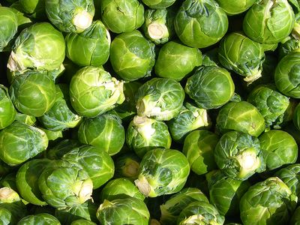“Nothing is more reassuring, nothing is more true to the comfortable spirit of English occultism, than the smell of Brussels sprouts cooking.” — Terry Pratchett
Brussels sprouts look like baby cabbages because they’re part of the same fam- ily; however, unlike cabbages where we eat the head that comes out of the ground, Brussels sprouts are buds that grow along the length of a thick, fibrous stalk.
They are among the most powerful cold-weather superfoods.




Benefits and nutritional information:
- You may have noted that Brussels sprouts came in fifth on the list of the most healthful vegetables to eat. Like its relative, the cabbage, it is a low calorie, high fiber vegetable with an impressive nutrient profile.
- It is rich in vitamins, micronutrients, and antioxidants; cancer-fighting flavonoids and phytonutrients which fight inflammation and arthritis.
- On the other hand, it’s more highly rated than cabbage because it has a higher concentration of immunity- boosting Vitamin C and cancer-fighting gulcosinolates.
- Just a half cup of cooked Brussels sprouts provides 137% of your daily vitamin K — a nutrient that plays a vital role in many functions including promoting bone growth.
Starting:
- Brussels sprouts can be started from seeds or transplants. Seeds are best started in individual pots.
When to plant:
- Brussels sprouts require a long growing season — 90 to 120 days. Commonly they are planted in late spring up to mid-summer for harvest beginning in the fall.
- Being a cool weather crop, they do best in temperatures between 60 and 70 degrees Fahrenheit. Mature plants can withstand temperatures as low as 25 degrees, and during most winters we have been able to grow Brussels sprouts through the winter.
Thinning, training
- Plants should be spaced 16 to 18 inches apart in order to develop the best yields.
- Throughout the growing season, observe your plants regularly and strip off any leaves that start to turn yellow.
- If you choose, you can actually remove all of the lower leaves regardless of whether they are beginning to lose color. This will speed up the time they take to mature by encouraging the plants to direct energy towards producing buds.
Signs of over-watering, nutrient deficiency
- Brussels sprouts need a constant supply of nitrogen to have enough vegetation to produce sprouts. Therefore, yellowed leaves or lack of sprouts can indicate low nitrogen.
- Over-watering leads to waterlogged soil around the plant’s roots which, in turn, results in root rot and a dead plant.
Pests and pest controls
- Common insect pests are aphids, cabbage worms, cabbage loopers and cutworms.
Harvesting
- The best time to harvest is in the fall, after the plants have been touched by afew light frosts. Frost actually improves their flavor. This is because the drop in temperature triggers the plants to devote energy to producing sugar.
- The sprouts are ready to harvest when firm, bright green, and about 1 to 1.5inches in diameter.
- As soon as at least a few are fully developed you can begin harvesting. As you pick them off, new ones will continue to form on the plant.
- Brussels sprouts mature from the bottom of the plant upward, so the lowest ones will be ready first. When harvesting, start by picking those that are lower on the stalk, and work your way upwards.
- Twist or snap off the buds, or cut them with a knife at the base where the sprout meets the stem. Be sure to pick them before they start to turn yellow, as they will become bitter and tough.
- You can continue to harvest as long as there are sprouts on the plant. As the weather warms up, the plant will eventually bolt and no longer produce buds.
- Other information, resources and articles
A 2008 survey by Heinz revealed that Brussels sprouts are the most-hated vegetable in America. That’s somewhat easy to understand in that the most common way to prepare them is to boil or steam until they’re soft, mushy and therefore have released bad-smelling sulfur compounds. - On the other hand, properly roasted or pan-fried Brussels sprouts are increasingly popular.
- Adding a dash of balsamic vinegar at the end enhances the flavor even more.
